外研版(2019)高中英语选择性必修第二册 Unit3 Times change! Developing ideas and Presenting ideas 名师教学设计
文档属性
| 名称 | 外研版(2019)高中英语选择性必修第二册 Unit3 Times change! Developing ideas and Presenting ideas 名师教学设计 | 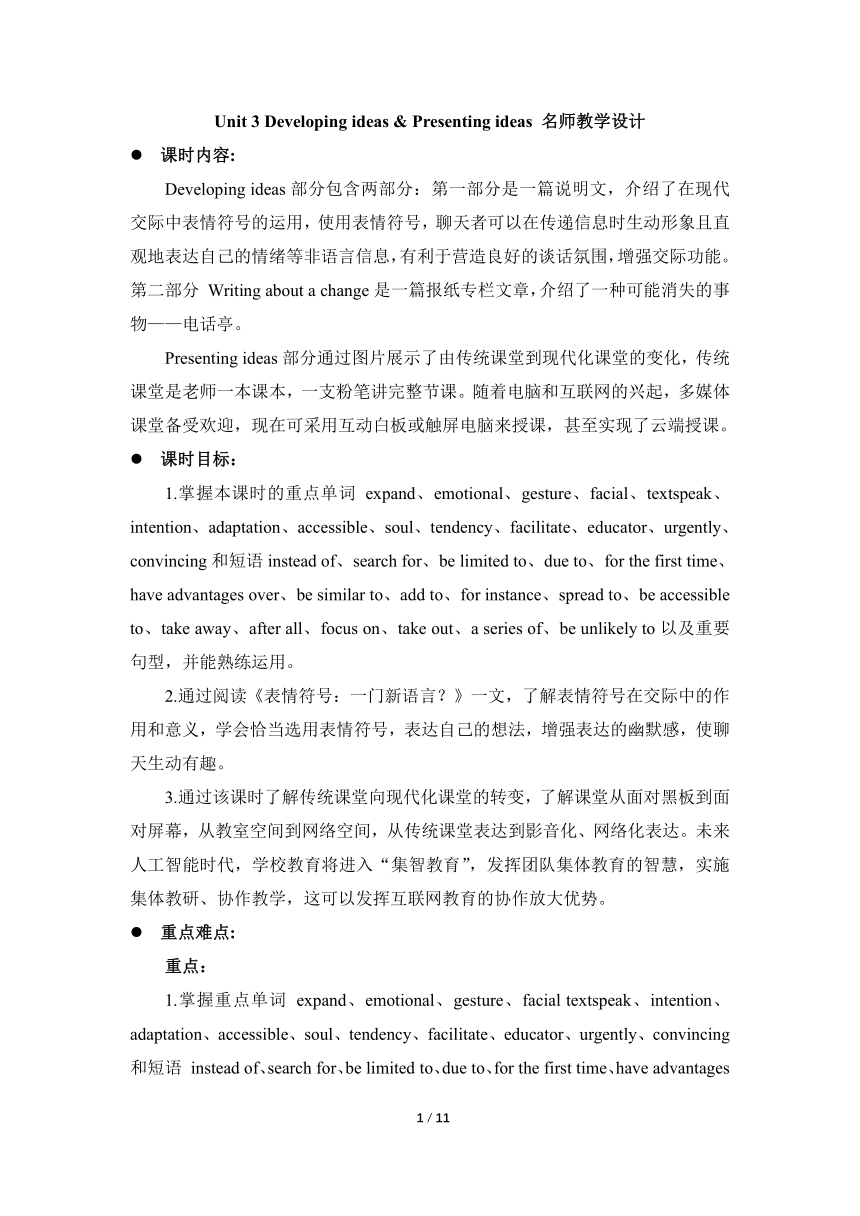 | |
| 格式 | docx | ||
| 文件大小 | 4.0MB | ||
| 资源类型 | 教案 | ||
| 版本资源 | 外研版(2019) | ||
| 科目 | 英语 | ||
| 更新时间 | 2023-03-03 16:32:19 | ||
图片预览

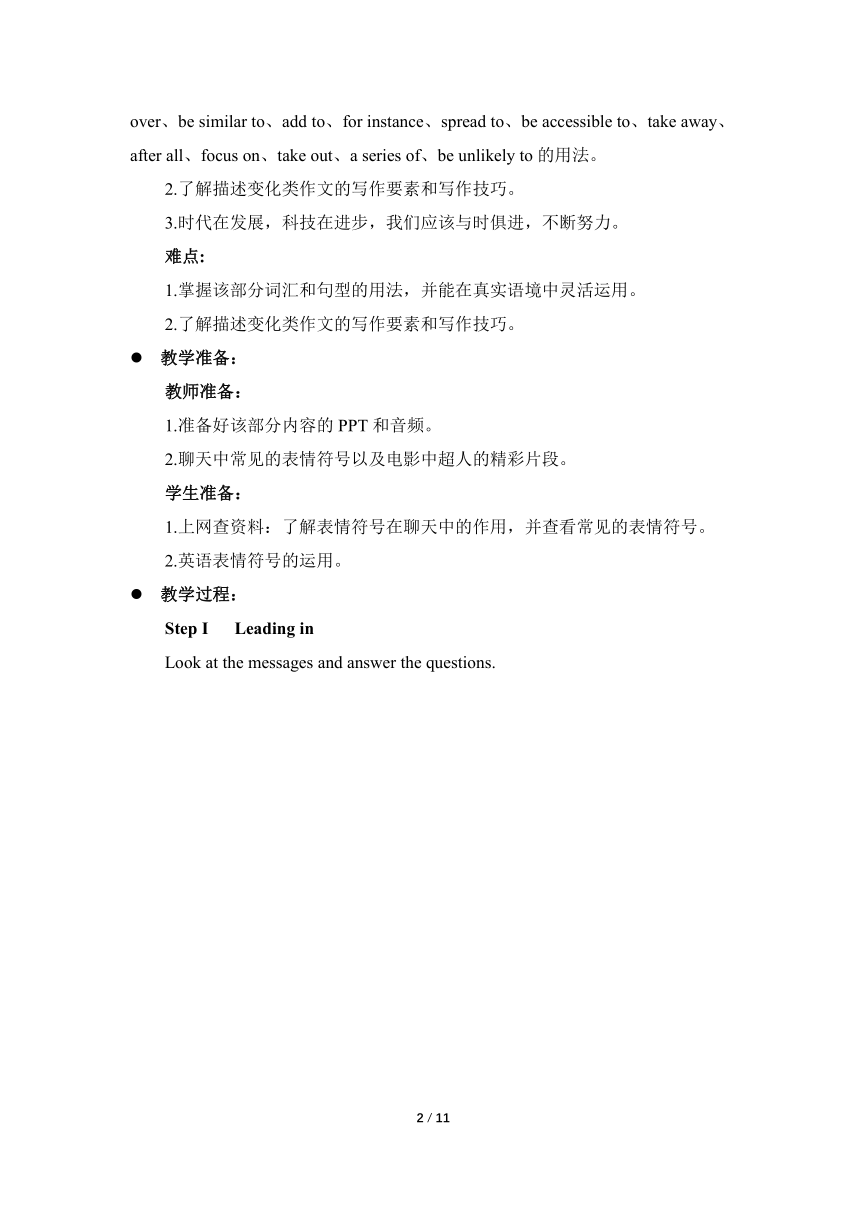
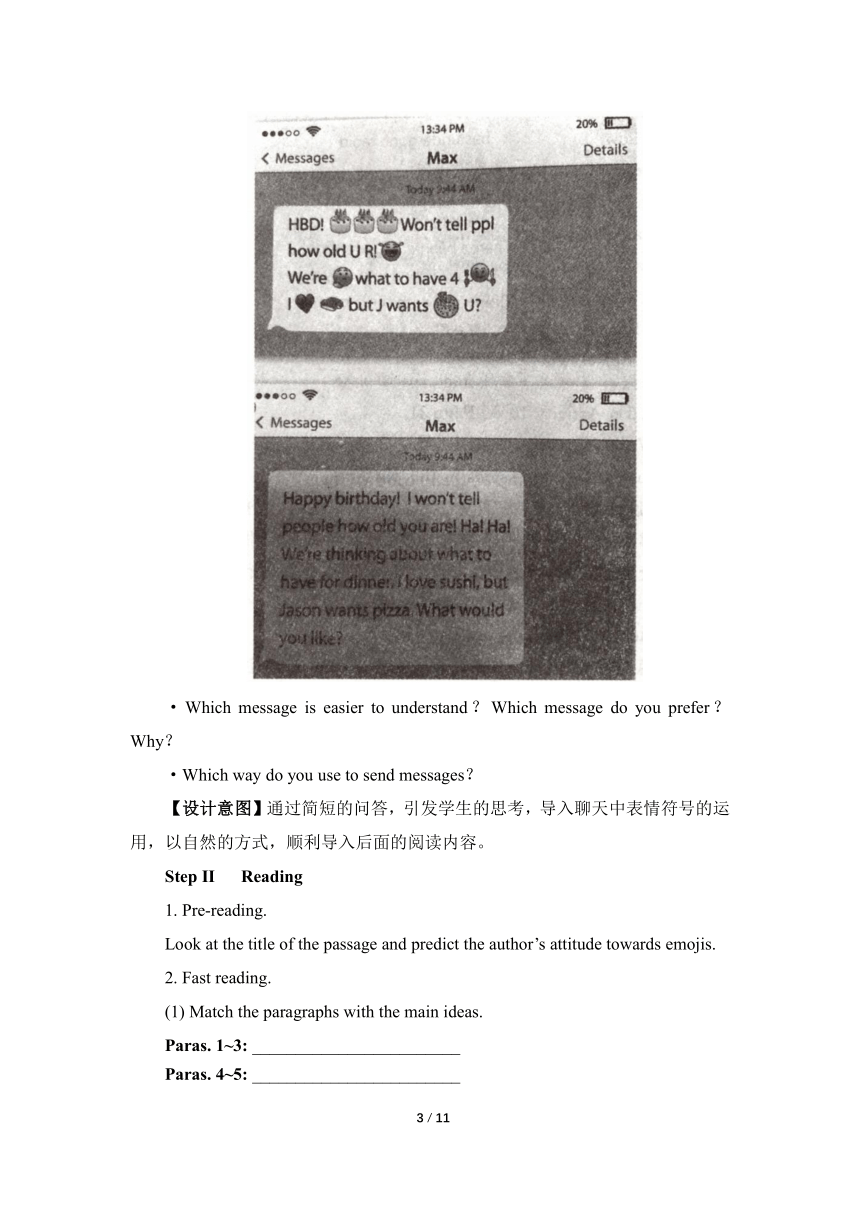
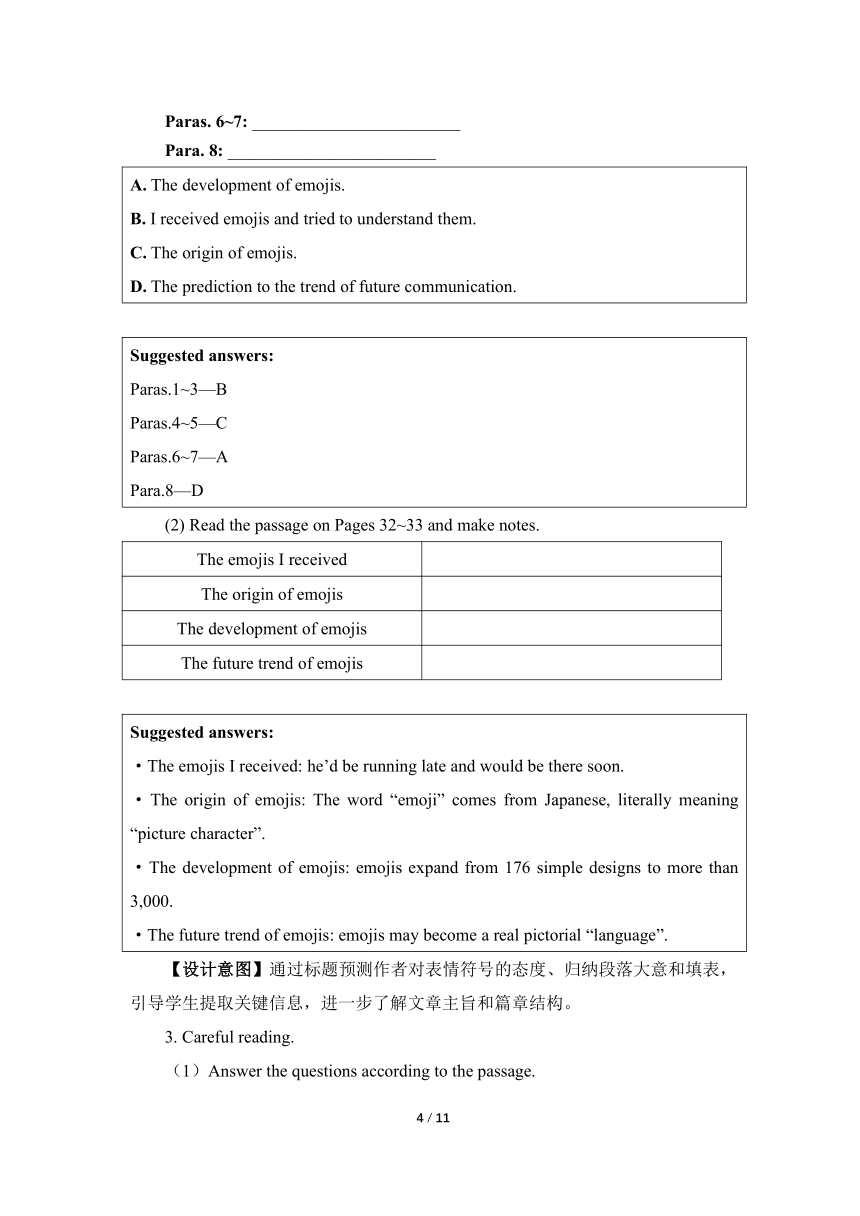
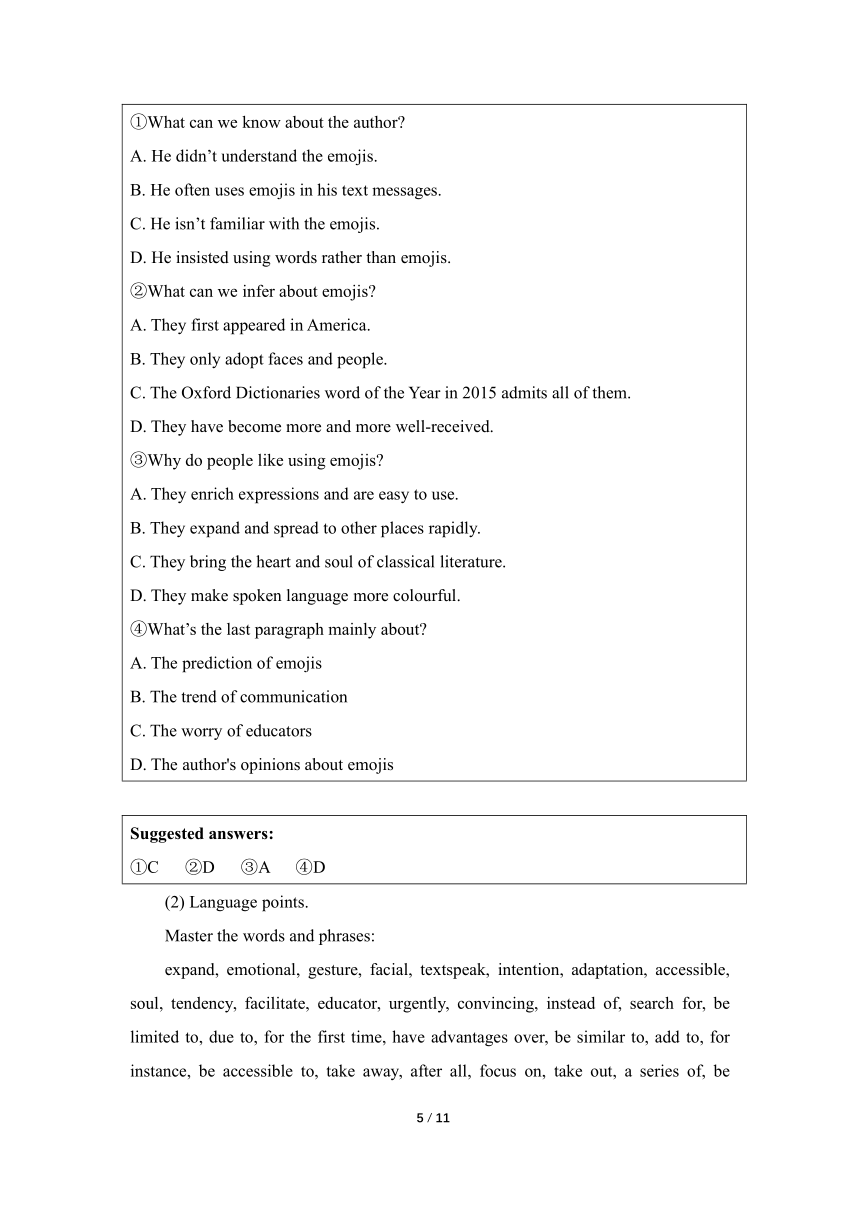
文档简介
Unit 3 Developing ideas & Presenting ideas 名师教学设计
课时内容:
Developing ideas部分包含两部分:第一部分是一篇说明文,介绍了在现代交际中表情符号的运用,使用表情符号,聊天者可以在传递信息时生动形象且直观地表达自己的情绪等非语言信息,有利于营造良好的谈话氛围,增强交际功能。第二部分 Writing about a change是一篇报纸专栏文章,介绍了一种可能消失的事物——电话亭。
Presenting ideas部分通过图片展示了由传统课堂到现代化课堂的变化,传统课堂是老师一本课本,一支粉笔讲完整节课。随着电脑和互联网的兴起,多媒体课堂备受欢迎,现在可采用互动白板或触屏电脑来授课,甚至实现了云端授课。
课时目标:
1.掌握本课时的重点单词 expand、emotional、gesture、facial、textspeak、intention、adaptation、accessible、soul、tendency、facilitate、educator、urgently、convincing和短语instead of、search for、be limited to、due to、for the first time、have advantages over、be similar to、add to、for instance、spread to、be accessible to、take away、after all、focus on、take out、a series of、be unlikely to以及重要句型,并能熟练运用。
2.通过阅读《表情符号:一门新语言?》一文,了解表情符号在交际中的作用和意义,学会恰当选用表情符号,表达自己的想法,增强表达的幽默感,使聊天生动有趣。
3.通过该课时了解传统课堂向现代化课堂的转变,了解课堂从面对黑板到面对屏幕,从教室空间到网络空间,从传统课堂表达到影音化、网络化表达。未来人工智能时代,学校教育将进入“集智教育”,发挥团队集体教育的智慧,实施集体教研、协作教学,这可以发挥互联网教育的协作放大优势。
重点难点:
重点:
1.掌握重点单词 expand、emotional、gesture、facial textspeak、intention、adaptation、accessible、soul、tendency、facilitate、educator、urgently、convincing和短语 instead of、search for、be limited to、due to、for the first time、have advantages over、be similar to、add to、for instance、spread to、be accessible to、take away、after all、focus on、take out、a series of、be unlikely to的用法。
2.了解描述变化类作文的写作要素和写作技巧。
3.时代在发展,科技在进步,我们应该与时俱进,不断努力。
难点:
1.掌握该部分词汇和句型的用法,并能在真实语境中灵活运用。
2.了解描述变化类作文的写作要素和写作技巧。
教学准备:
教师准备:
1.准备好该部分内容的PPT和音频。
2.聊天中常见的表情符号以及电影中超人的精彩片段。
学生准备:
1.上网查资料:了解表情符号在聊天中的作用,并查看常见的表情符号。
2.英语表情符号的运用。
教学过程:
Step I Leading in
Look at the messages and answer the questions.
·Which message is easier to understand?Which message do you prefer?Why?
·Which way do you use to send messages?
【设计意图】通过简短的问答,引发学生的思考,导入聊天中表情符号的运用,以自然的方式,顺利导入后面的阅读内容。
Step Ⅱ Reading
1. Pre-reading.
Look at the title of the passage and predict the author’s attitude towards emojis.
2. Fast reading.
(1) Match the paragraphs with the main ideas.
Paras. 1~3: ________________________
Paras. 4~5: ________________________
Paras. 6~7: ________________________
Para. 8: ________________________
A. The development of emojis. B. I received emojis and tried to understand them. C. The origin of emojis. D. The prediction to the trend of future communication.
Suggested answers: Paras.1~3—B Paras.4~5—C Paras.6~7—A Para.8—D
(2) Read the passage on Pages 32~33 and make notes.
The emojis I received
The origin of emojis
The development of emojis
The future trend of emojis
Suggested answers: ·The emojis I received: he’d be running late and would be there soon. ·The origin of emojis: The word “emoji” comes from Japanese, literally meaning “picture character”. ·The development of emojis: emojis expand from 176 simple designs to more than 3,000. ·The future trend of emojis: emojis may become a real pictorial “language”.
【设计意图】通过标题预测作者对表情符号的态度、归纳段落大意和填表,引导学生提取关键信息,进一步了解文章主旨和篇章结构。
3. Careful reading.
(1)Answer the questions according to the passage.
①What can we know about the author A. He didn’t understand the emojis. B. He often uses emojis in his text messages. C. He isn’t familiar with the emojis. D. He insisted using words rather than emojis. ②What can we infer about emojis A. They first appeared in America. B. They only adopt faces and people. C. The Oxford Dictionaries word of the Year in 2015 admits all of them. D. They have become more and more well-received. ③Why do people like using emojis A. They enrich expressions and are easy to use. B. They expand and spread to other places rapidly. C. They bring the heart and soul of classical literature. D. They make spoken language more colourful. ④What’s the last paragraph mainly about A. The prediction of emojis B. The trend of communication C. The worry of educators D. The author's opinions about emojis
Suggested answers: ①C ②D ③A ④D
(2) Language points.
Master the words and phrases:
expand, emotional, gesture, facial, textspeak, intention, adaptation, accessible, soul, tendency, facilitate, educator, urgently, convincing, instead of, search for, be limited to, due to, for the first time, have advantages over, be similar to, add to, for instance, be accessible to, take away, after all, focus on, take out, a series of, be unlikely to
【备注】词汇知识点讲解详见第二教案“新知探究”。
(3)Read the passage again and retell it.
【设计意图】复述的过程是将学过的文章经过加工处理,用自已的语言,以口头形式进行表达。这种表述不是对已知材料简单的、机械的重复,而是经过自己大脑语言中枢的“加工”,创造性地再现已知语言材料的内容。教师要在每个学生复述完毕后给予中肯的评价及热情的鼓励,同时纠正一些错误。通过反馈,复述者本人及其他学生可以分享成功的喜悦,互相学习,互相借鉴,使以后的课文复述变得更好、更精彩。
4. Post-reading.
(1)Do Activity 3 on Page 34.
Choose the author’s purpose in writing the passage and give your reasons.
①To guide readers to use emojis properly. ②To discuss the development and influence of emojis. ③To criticise the increased use of emojis. ④To entertain readers with examples of how emojis have been used.
Suggested answers: ②
(2) Do Activity 4 on Page 34.
Work in groups. Give a talk about the sentence from the passage.
①Go through the sentences in Learning to learn and make sure students understand their meanings.
②Read the sentence and decide whether you agree or disagree with it.
③Provide three reasons to support your ideas and give evidence for each reason. Make notes.
④Give your talk to the class.
【设计意图】首先明确观点,再列举原因和证据。锻炼学生的语言材料整理能力和表述能力。
Step III Writing about a change
Do Activities 5~7 on Page 35.
(1) Read the passage and answer the questions.
·Why does the author start the passage by writing about Superman
·What will disappear in the future according to the passage What is the major reason for this phenomenon
·What supporting arguments does the author give to make the point convincing
Suggested answers: ·The author starts by writing about Superman in order to form an instant connection with readers, as everyone is familiar with Superman. It also sets the tone of the passage by introducing some light-hearted humour. ·Phone boxes will disappear in the future. The major reason is that almost everyone has a mobile phone and they don’t need phone boxes any more. ·The supporting arguments are as follows: □Phone boxes are difficult to find. □It is more convenient to take out a mobile and make a call at the touch of a button than to press a series of long numbers. □Remembering others’ telephone numbers Is not easy. □It is more convenient to borrow a mobile phone from someone else than walk around looking for a phone box.
(2) Think about something that might disappear in the future and complete the table.
Something that will not be around in the future
Reasons
Supporting arguments
(3)Now write your passage.
(4)Work in pairs. Make improvements to each other’s passages and share them with the class.
【设计意图】通过读短文回答问题,思考将来会消失的事物及互检互评,深入思考时代变迁带来的影响,丰富学生的跨文化知识,培养学生的分析问题的能力及语言表达能力。
Step IV Presenting ideas
1. Work in groups. Look at the pictures and answer the questions.
·What can you see in the pictures
·What changes in our ways of learning do the pictures show
Suggested answers: ·(略) ·The pictures show changes in classroom conditions,teaching tools,ways of interacting and access to resources.
(2) Think about how learning will change in the future and complete the table.
Learning activities Changes
homework
exam
3. Prepare a short presentation. Consider the following:
·the structure of your presentation
·useful words,expressions and structures
4. Give your presentation to the class.
【设计意图】通过观察并描述图片,思考学生的学习方式发生了怎样的变化,并预测未来学习活动的变化趋势,锻炼学生的表达能力和胆量,培养学生开口说英语的习惯。
Step V Homework
Review the language points learnt in class.
板书设计:
Unit 3 Times change! Period Ⅲ Developing ideas & Presenting ideas I. Leading in Look at the messages and answer the questions. Ⅱ. Reading 1. Pre-reading. Look at the title of the passage and predict the author’s attitude towards emojis. 2. Fast reading. (1) Match the paragraphs with the main ideas. (2) Read the passage on Pages 32~33 and make notes. 3. Careful reading. (1) Answer the questions according to the passage. (2) Language points. Master the words and phrases: expand, emotional, gesture, facial, textspeak, intention, adaptation, accessible, soul, tendency, facilitate, educator, urgently, convincing, instead of, search for, be limited to, due to, for the first time, have advantages over, be similar to, add to, for instance, be accessible to, take away, after all, focus on, take out, a series of, be unlikely to (3) Read the passage again and retell it. 4. Post-reading. (1) Do Activity 3 on Page 34. (2) Do Activity 4 on Page 34. Ⅲ. Writing about a change Do Activities 5~7 on Page 35. IV. Presenting ideas V. Homework
1 / 11
课时内容:
Developing ideas部分包含两部分:第一部分是一篇说明文,介绍了在现代交际中表情符号的运用,使用表情符号,聊天者可以在传递信息时生动形象且直观地表达自己的情绪等非语言信息,有利于营造良好的谈话氛围,增强交际功能。第二部分 Writing about a change是一篇报纸专栏文章,介绍了一种可能消失的事物——电话亭。
Presenting ideas部分通过图片展示了由传统课堂到现代化课堂的变化,传统课堂是老师一本课本,一支粉笔讲完整节课。随着电脑和互联网的兴起,多媒体课堂备受欢迎,现在可采用互动白板或触屏电脑来授课,甚至实现了云端授课。
课时目标:
1.掌握本课时的重点单词 expand、emotional、gesture、facial、textspeak、intention、adaptation、accessible、soul、tendency、facilitate、educator、urgently、convincing和短语instead of、search for、be limited to、due to、for the first time、have advantages over、be similar to、add to、for instance、spread to、be accessible to、take away、after all、focus on、take out、a series of、be unlikely to以及重要句型,并能熟练运用。
2.通过阅读《表情符号:一门新语言?》一文,了解表情符号在交际中的作用和意义,学会恰当选用表情符号,表达自己的想法,增强表达的幽默感,使聊天生动有趣。
3.通过该课时了解传统课堂向现代化课堂的转变,了解课堂从面对黑板到面对屏幕,从教室空间到网络空间,从传统课堂表达到影音化、网络化表达。未来人工智能时代,学校教育将进入“集智教育”,发挥团队集体教育的智慧,实施集体教研、协作教学,这可以发挥互联网教育的协作放大优势。
重点难点:
重点:
1.掌握重点单词 expand、emotional、gesture、facial textspeak、intention、adaptation、accessible、soul、tendency、facilitate、educator、urgently、convincing和短语 instead of、search for、be limited to、due to、for the first time、have advantages over、be similar to、add to、for instance、spread to、be accessible to、take away、after all、focus on、take out、a series of、be unlikely to的用法。
2.了解描述变化类作文的写作要素和写作技巧。
3.时代在发展,科技在进步,我们应该与时俱进,不断努力。
难点:
1.掌握该部分词汇和句型的用法,并能在真实语境中灵活运用。
2.了解描述变化类作文的写作要素和写作技巧。
教学准备:
教师准备:
1.准备好该部分内容的PPT和音频。
2.聊天中常见的表情符号以及电影中超人的精彩片段。
学生准备:
1.上网查资料:了解表情符号在聊天中的作用,并查看常见的表情符号。
2.英语表情符号的运用。
教学过程:
Step I Leading in
Look at the messages and answer the questions.
·Which message is easier to understand?Which message do you prefer?Why?
·Which way do you use to send messages?
【设计意图】通过简短的问答,引发学生的思考,导入聊天中表情符号的运用,以自然的方式,顺利导入后面的阅读内容。
Step Ⅱ Reading
1. Pre-reading.
Look at the title of the passage and predict the author’s attitude towards emojis.
2. Fast reading.
(1) Match the paragraphs with the main ideas.
Paras. 1~3: ________________________
Paras. 4~5: ________________________
Paras. 6~7: ________________________
Para. 8: ________________________
A. The development of emojis. B. I received emojis and tried to understand them. C. The origin of emojis. D. The prediction to the trend of future communication.
Suggested answers: Paras.1~3—B Paras.4~5—C Paras.6~7—A Para.8—D
(2) Read the passage on Pages 32~33 and make notes.
The emojis I received
The origin of emojis
The development of emojis
The future trend of emojis
Suggested answers: ·The emojis I received: he’d be running late and would be there soon. ·The origin of emojis: The word “emoji” comes from Japanese, literally meaning “picture character”. ·The development of emojis: emojis expand from 176 simple designs to more than 3,000. ·The future trend of emojis: emojis may become a real pictorial “language”.
【设计意图】通过标题预测作者对表情符号的态度、归纳段落大意和填表,引导学生提取关键信息,进一步了解文章主旨和篇章结构。
3. Careful reading.
(1)Answer the questions according to the passage.
①What can we know about the author A. He didn’t understand the emojis. B. He often uses emojis in his text messages. C. He isn’t familiar with the emojis. D. He insisted using words rather than emojis. ②What can we infer about emojis A. They first appeared in America. B. They only adopt faces and people. C. The Oxford Dictionaries word of the Year in 2015 admits all of them. D. They have become more and more well-received. ③Why do people like using emojis A. They enrich expressions and are easy to use. B. They expand and spread to other places rapidly. C. They bring the heart and soul of classical literature. D. They make spoken language more colourful. ④What’s the last paragraph mainly about A. The prediction of emojis B. The trend of communication C. The worry of educators D. The author's opinions about emojis
Suggested answers: ①C ②D ③A ④D
(2) Language points.
Master the words and phrases:
expand, emotional, gesture, facial, textspeak, intention, adaptation, accessible, soul, tendency, facilitate, educator, urgently, convincing, instead of, search for, be limited to, due to, for the first time, have advantages over, be similar to, add to, for instance, be accessible to, take away, after all, focus on, take out, a series of, be unlikely to
【备注】词汇知识点讲解详见第二教案“新知探究”。
(3)Read the passage again and retell it.
【设计意图】复述的过程是将学过的文章经过加工处理,用自已的语言,以口头形式进行表达。这种表述不是对已知材料简单的、机械的重复,而是经过自己大脑语言中枢的“加工”,创造性地再现已知语言材料的内容。教师要在每个学生复述完毕后给予中肯的评价及热情的鼓励,同时纠正一些错误。通过反馈,复述者本人及其他学生可以分享成功的喜悦,互相学习,互相借鉴,使以后的课文复述变得更好、更精彩。
4. Post-reading.
(1)Do Activity 3 on Page 34.
Choose the author’s purpose in writing the passage and give your reasons.
①To guide readers to use emojis properly. ②To discuss the development and influence of emojis. ③To criticise the increased use of emojis. ④To entertain readers with examples of how emojis have been used.
Suggested answers: ②
(2) Do Activity 4 on Page 34.
Work in groups. Give a talk about the sentence from the passage.
①Go through the sentences in Learning to learn and make sure students understand their meanings.
②Read the sentence and decide whether you agree or disagree with it.
③Provide three reasons to support your ideas and give evidence for each reason. Make notes.
④Give your talk to the class.
【设计意图】首先明确观点,再列举原因和证据。锻炼学生的语言材料整理能力和表述能力。
Step III Writing about a change
Do Activities 5~7 on Page 35.
(1) Read the passage and answer the questions.
·Why does the author start the passage by writing about Superman
·What will disappear in the future according to the passage What is the major reason for this phenomenon
·What supporting arguments does the author give to make the point convincing
Suggested answers: ·The author starts by writing about Superman in order to form an instant connection with readers, as everyone is familiar with Superman. It also sets the tone of the passage by introducing some light-hearted humour. ·Phone boxes will disappear in the future. The major reason is that almost everyone has a mobile phone and they don’t need phone boxes any more. ·The supporting arguments are as follows: □Phone boxes are difficult to find. □It is more convenient to take out a mobile and make a call at the touch of a button than to press a series of long numbers. □Remembering others’ telephone numbers Is not easy. □It is more convenient to borrow a mobile phone from someone else than walk around looking for a phone box.
(2) Think about something that might disappear in the future and complete the table.
Something that will not be around in the future
Reasons
Supporting arguments
(3)Now write your passage.
(4)Work in pairs. Make improvements to each other’s passages and share them with the class.
【设计意图】通过读短文回答问题,思考将来会消失的事物及互检互评,深入思考时代变迁带来的影响,丰富学生的跨文化知识,培养学生的分析问题的能力及语言表达能力。
Step IV Presenting ideas
1. Work in groups. Look at the pictures and answer the questions.
·What can you see in the pictures
·What changes in our ways of learning do the pictures show
Suggested answers: ·(略) ·The pictures show changes in classroom conditions,teaching tools,ways of interacting and access to resources.
(2) Think about how learning will change in the future and complete the table.
Learning activities Changes
homework
exam
3. Prepare a short presentation. Consider the following:
·the structure of your presentation
·useful words,expressions and structures
4. Give your presentation to the class.
【设计意图】通过观察并描述图片,思考学生的学习方式发生了怎样的变化,并预测未来学习活动的变化趋势,锻炼学生的表达能力和胆量,培养学生开口说英语的习惯。
Step V Homework
Review the language points learnt in class.
板书设计:
Unit 3 Times change! Period Ⅲ Developing ideas & Presenting ideas I. Leading in Look at the messages and answer the questions. Ⅱ. Reading 1. Pre-reading. Look at the title of the passage and predict the author’s attitude towards emojis. 2. Fast reading. (1) Match the paragraphs with the main ideas. (2) Read the passage on Pages 32~33 and make notes. 3. Careful reading. (1) Answer the questions according to the passage. (2) Language points. Master the words and phrases: expand, emotional, gesture, facial, textspeak, intention, adaptation, accessible, soul, tendency, facilitate, educator, urgently, convincing, instead of, search for, be limited to, due to, for the first time, have advantages over, be similar to, add to, for instance, be accessible to, take away, after all, focus on, take out, a series of, be unlikely to (3) Read the passage again and retell it. 4. Post-reading. (1) Do Activity 3 on Page 34. (2) Do Activity 4 on Page 34. Ⅲ. Writing about a change Do Activities 5~7 on Page 35. IV. Presenting ideas V. Homework
1 / 11
